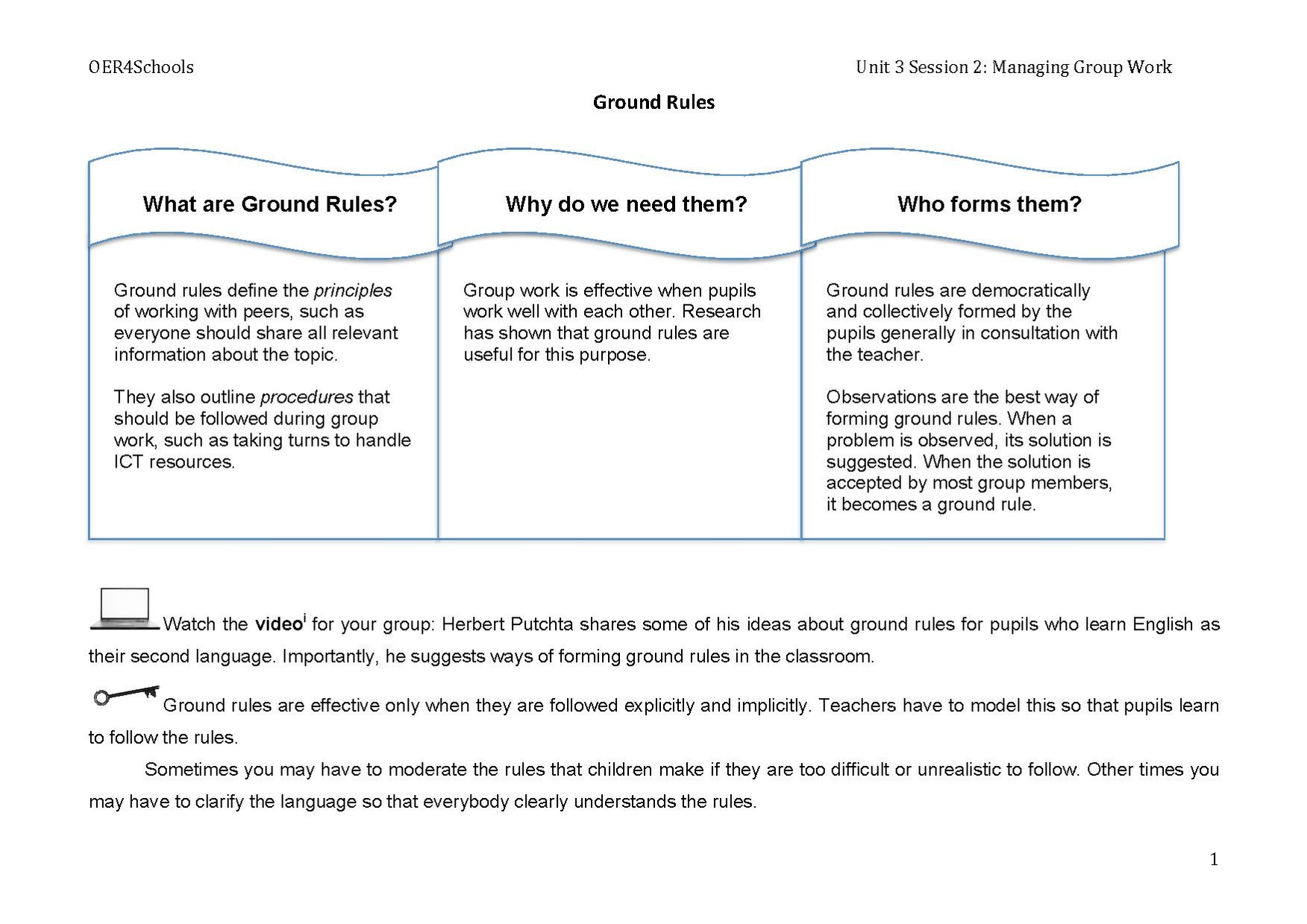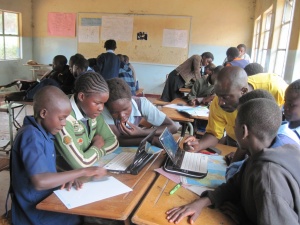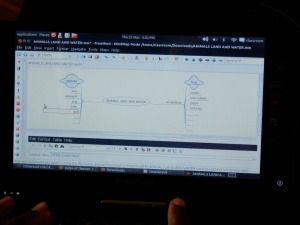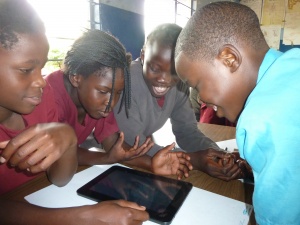OER4Schools/Supporting reasoning and managing group work: Difference between revisions
SimonKnight (talk | contribs) No edit summary |
SimonKnight (talk | contribs) No edit summary |
||
| Line 23: | Line 23: | ||
* Did you carry out a different-tasks group work activity in your class? What were the advantages of this type of group work? Share specific examples. | * Did you carry out a different-tasks group work activity in your class? What were the advantages of this type of group work? Share specific examples. | ||
* What issues did you face while teaching through group work? Specifically think about challenges related to pupils’ interaction with each other such as involving all members in discussion, dominant and shy pupils, agreement and disagreement, and noise. How did you resolve these issues? Write a note for yourself about the steps you will take to resolve these issues next time. | * What issues did you face while teaching through group work? Specifically think about challenges related to pupils’ interaction with each other such as involving all members in discussion, dominant and shy pupils, agreement and disagreement, and noise. How did you resolve these issues? Write a note for yourself about the steps you will take to resolve these issues next time. | ||
[[Image:small group work.jpg|300px|alt=small group of pupils gathered around a tablet computer]] | |||
= Objectives for this session= | = Objectives for this session= | ||
Revision as of 15:46, 17 August 2012
Review of homework and classroom activities
Whole group discussion: Concept mapping
- Did you try drawing concept maps on the netbooks? Were you able to use coloured boxes? Briefly share issues that you were able to resolve. Discuss issues that are still not resolved.
- Did you try the concept mapping activity with pupils in your class? How did the pupils respond to the activity, especially reasoning and building on each other’s responses? If they did this, how were you able to achieve it? Share specific examples of pupil talk and teacher talk.
- Did you use a digital projector in the class? Was it useful for the concept mapping activity? Why?
- What would you change when you carry out the concept mapping activity again? Make a note for yourself about any changes so you can remember for next time.
Get into the same three groups that were formed during the last session for same-task and different-tasks activity (Unit 3 Session 1, Activity 3)
Small group discussion: Groupwork activities
- The volunteers who posted questions for group work on the googlegroups should share their experience of working on googlegroups. How difficult or easy was this? Would you recommend other participants to try it? What advice would you give them?
- Did you carry out a same-task group work activity in your class? Which topic did you choose? Was there any pupil learning about the topic that could be achieved through group work but would not be possible through whole class teaching? Elaborate your answer.
- Did you carry out a different-tasks group work activity in your class? What were the advantages of this type of group work? Share specific examples.
- What issues did you face while teaching through group work? Specifically think about challenges related to pupils’ interaction with each other such as involving all members in discussion, dominant and shy pupils, agreement and disagreement, and noise. How did you resolve these issues? Write a note for yourself about the steps you will take to resolve these issues next time.
Objectives for this session
- Substantiating uses of group work for teaching and learning
- Learning to manage group work effectively in the classroom
- Learning different organisational strategies for group work
Activity: Reinforcing understanding of group work
Magic Microphone for reasoning
A. ![]() Individual activity (11 min). Think of answers to the question below. You can write them on a mini-blackboard or sheet of paper for reference during the activity. Think of as many answers as possible and give a reason in each case. (Tip: think of the Powerpoint presentation about questioning strategies that you saw in the previous session and draw on your own experience of carrying out group work in the classroom.)
Individual activity (11 min). Think of answers to the question below. You can write them on a mini-blackboard or sheet of paper for reference during the activity. Think of as many answers as possible and give a reason in each case. (Tip: think of the Powerpoint presentation about questioning strategies that you saw in the previous session and draw on your own experience of carrying out group work in the classroom.)
- When would you use group work in your classroom? Why? Give concrete examples of specific lesson activities where possible. For example,
- when a topic has many sub-topics because the sub-topics can be mastered by small groups and then taught to other groups, as in different types of pollution
- when summarising the topic that has extended over many lessons [give example] because pupils can remind each other about the things that they have learnt without repetition by the teacher
- when applications of a topic [give example] are being discussed because there can be many answers for this
We did a simple version of the magic microphone activity in Unit 2 Session 1. Now we are taking this to the next level to explicitly promote reasoning among participants as well as pupils.
For this activity, you will need a prop such as a stick, a pen, a ball or an empty water bottle.
Allow 8-10 minutes thinking time before passing around the prop.
B. ![]() Whole group (11 min). Pass a prop around. Whoever has the prop answers the question above and gives their reason(s).
Whole group (11 min). Pass a prop around. Whoever has the prop answers the question above and gives their reason(s).
Ask every participant to contribute one answer initially, with a reason. Encourage them to avoid repeating an answer that has been already said. In the end, if time permits, you can ask participants to contribute any reason that they have written but has not yet been said by any other participant.
Emphasise that participants should give reasons for their answers or answer the ‘why’ question. Ideally they should mention a specific lesson topic example.
Some examples of expected answers are:
- when peers can be useful learning resources for each other
- to encourage sharing, reasoning and challenging of ideas
- to support pupils’ construction and articulation of their own understanding of problems, processes or concepts
- when groups can usefully each contribute one part to a larger whole task
- when the teacher wants learners to investigate a topic for themselves and present their findings to the class for other groups to learn from, perhaps via comparison of findings
- when teacher attention is required for conceptual learning of a small number of participants at one time
- at any stage of the lesson: introduction, development and consolidation
If any of the points above are not mentioned by participants, you can state them in the end.
Activity: Managing group work
Place three containers (or sheets of paper) on the table. Label them ‘same-task’, ‘different-tasks’ and ‘both’.
Write your name on a slip (small piece) of paper and fold it. Drop your name slip in the ‘same-task’ container if you are confident about carrying out same-task group activity in the class. Similarly, drop it in the container ‘different-tasks’ if you are confident about carrying out different-tasks and ‘both’ container if you are confident about ‘both’.
Pull out one name from each container and group them together as Group 1 (G1). Similarly form groups G2 and G3.
If there are too many names in one container and too few in another, choose another strategy of forming groups from the document ‘Group composition and formation’.
The three mixed groups will work on different aspects of managing group work in classroom. They are:
- G1: Group composition and formation (
 )
) - G2: Ground rules during group work (
 )
) - G3: Group size and seating arrangement (
 )
)
Read the document for your group. Do the group tasks mentioned in your document.
Group G2 will watch a video during their task.
At the end, present what you have learned about managing group work for the benefit of other participants (see details in your document).
VIDEO
How_to_Involve_Students_in_Setting_Up_Their_Own_Ground_Rules.mp4
The description of the video
Video/How to Involve Students in Setting Up Their Own Ground Rules.mp4, https://oer.opendeved.net/wiki/Video/How_to_Involve_Students_in_Setting_Up_Their_Own_Ground_Rules.mp4, Duration: 4:08 watch on YouTube, local play / download options / download from dropbox)
Before the session starts prepare this video clip for G2 to access on a netbook. Ask G2 members to sit near the netbook during the task.
Allow G1 and G3 participants to choose an area where they wish to work.
Distribute the document ‘ ’ to G1, ‘
’ to G1, ‘ ’ to G2 and ‘
’ to G2 and ‘ ’ to G3 at this stage.
’ to G3 at this stage.
Allow 30 minutes for the group tasks. After 20 minutes, remind the groups that they should start preparing their presentation if they have not already done so.
Visit each group during the group task. Assist them if they need help in understanding the information in the document or group task. Ask questions to monitor understanding. Suggest ideas only if the participants ask for your suggestions.
Ensure that all participants have all documents before the presentations at the end of this activity.
Activity: Reflection on video
VIDEO
Primary_Science_-_Classroom_Organisation.mp4
The description of the video
Video/Primary Science - Classroom Organisation.mp4, https://oer.opendeved.net/wiki/Video/Primary_Science_-_Classroom_Organisation.mp4, Duration: 19:47 watch on YouTube, local play / download options / download from dropbox)
This video shows some classroom organisational strategies mainly around group work. Although the video describes science teaching in the UK context, the principles are generic and can be applied in various curriculum areas and contexts. The organisation called the ‘circus of activities’ is commonly known as a ‘carousel’.
Suggested questions for reflection on video:
- Summarise the different classroom organisation strategies that you saw in this video:
- Whole class introduction
- Whole class doing same practical activity
- Groups doing different practical activities
- Circus of activities or carousel of activities
- One group only doing science
- Whole class demonstration
- Sharing science books with the whole class
- What is one new thing that you have learned from this video? How can you transfer what you have learned to another curriculum area besides science?
- How did the teachers in this video make use of ICT resources during group work? Suggest some ways in which you can use those or other ICT resources in your classroom? (You can also think of improvising with the materials available in your surroundings, if there is no ICT)
- What is the role of teachers before the group work and after the group work? Is it different from your current practice? If yes, in what ways is it different?
- What did the teachers in the video do while the pupils were doing group work? Is it different from your current practice? If yes, what changes, if any, would you like to make for effective group work in your class?
- What do you think about noise in the classroom during group work from this video? What can you do to make sure that noise is productive during group work?
Homework
- Try the magic microphone activity with reasoning in your class. Form an open question that is related to the topic that they are learning followed by ‘why’. Encourage them to answer the ‘why’ question.
- List examples of objectives that can be achieved through different types of groups in the document ‘Group composition and formation’.
- During the second Activity you read one document on managing group work. Read the other two documents. Write down any questions that you might have about them.
- Try one new organisational strategy that you saw in the video in your classroom, in any curriculum area.




